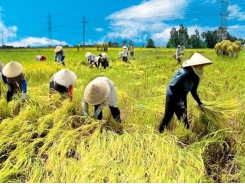Kiên Giang widens efficient rice farming, aquaculture models

KIÊN GIANG — The Cửu Long (Mekong) Delta province of Kiên Giang has expanded its most efficient rice and aquatic species farming models in the last two years.
Harvesting white-legged shrimp in Kiên Giang Province’s An Minh District. — VNA/VNS Photo Lê Huy Hải
Mai An Nhịn, deputy chairman of the province People’s Committee, said many farmers have switched from growing rice, in case of low yields, to breeding aquatic species.
They have also expanded the model of rotating between rice in the rainy season and shrimp in the dry season on the same fields to enhance their incomes, he said.
The model is particularly suitable for coastal areas since it helps adapt to climate change and rising sea levels.
The province has 92,000ha of rice – shrimp fields, the highest in the delta.
Farmers adopting the model harvest around four tonnes of paddy and 250 kilogrammes of black tiger shrimp per hectare per year.
The province has adopted several efficient shrimp farming models like extensive, intensive, semi-intensive, and two-stage industrial models.
The model of breeding white-legged shrimp in two stages to Vietnamese good agricultural practice (VietGAP) standards adopted in An Minh District for the last two years provides farmers with high incomes and protects the environment.
Juvenile shrimp are first bred in a small pond for a few weeks before being transferred to the main pond at a rate of up to 450 per square metre.
Lê Văn Khanh, head of the An Minh District Agriculture and Rural Development Bureau, said the success rate of the two-stage shrimp farming model is more than 90 per cent and farmers can breed two or three crops a year.
Farmers can earn VNĐ150-200 million (US$6,450-8,600) per 500-1,200sq.m pond per crop, he said.
The province, the country’s largest rice producer, has increased the number of rice crops in a year from two to three in areas like Tân Hiệp, Giồng Riềng and Hòn Đất districts where there are flood-prevention embankments.
In the coastal areas of U Minh Thượng and the Long Xuyên Quadrangle, farmers have developed the rice – shrimp model to earn high incomes.
In Giang Thành, Hòa Đất, Vĩnh Thuận and Giồng Riềng districts, where farmers grew only rice in the past, they now grow one rice and one other crop annually.
After growing the winter – spring rice crop, they grow vegetables, water melon or honeydew melon.
Phạm Hùng Em, who grows one rice crop and one vegetable crop in Vĩnh Thuận’s Vĩnh Bình Bắc Commune, said the income from vegetables is more than VNĐ200 million per hectare per year.
The province has researched to develop high-quality rice strains and aquatic breeds.
It has created rice varieties like GKG1 and GKG9 that have a short maturity period, are resistant to disease and saltwater, and have high yield and quality.
Farmers in the province grow more high-quality rice varieties, with the rate increasing from 71 per cent in 2016 to 75 per cent last year.
Last year, the province had 75,000ha of large-scale rice fields which involved more than 20 companies and farmers having tie-ups to ensure each other production and outlets.
The large-scale rice fields apply the “1 must and 5 reductions” method, which requires farmers to use certified seeds and reduce seeding, plant protection chemicals, nitrogen fertilisers, irrigation, and post-harvest losses.
Participating farmers can earn profits of 40 per cent.
The province has invested in irrigation systems, including building more sluices to keep out saltwater, to benefit rice and shrimp farming.
It dredged thousands of kilometres of irrigation canals and ditches, upgraded irrigation works in rice farming areas and established more than 1,250 pumping stations in the past two years.
Có thể bạn quan tâm
Phần mềm

Phối trộn thức ăn chăn nuôi

Pha dung dịch thủy canh

Định mức cho tôm ăn

Phối trộn phân bón NPK

Xác định tỷ lệ tôm sống

Chuyển đổi đơn vị phân bón

Xác định công suất sục khí

Chuyển đổi đơn vị tôm

Tính diện tích nhà kính

Tính thể tích ao hồ



 Pork imports spike, Vietnam's livestock industry under pressure
Pork imports spike, Vietnam's livestock industry under pressure  Việt Nam’s agricultural sector to face fierce competition
Việt Nam’s agricultural sector to face fierce competition